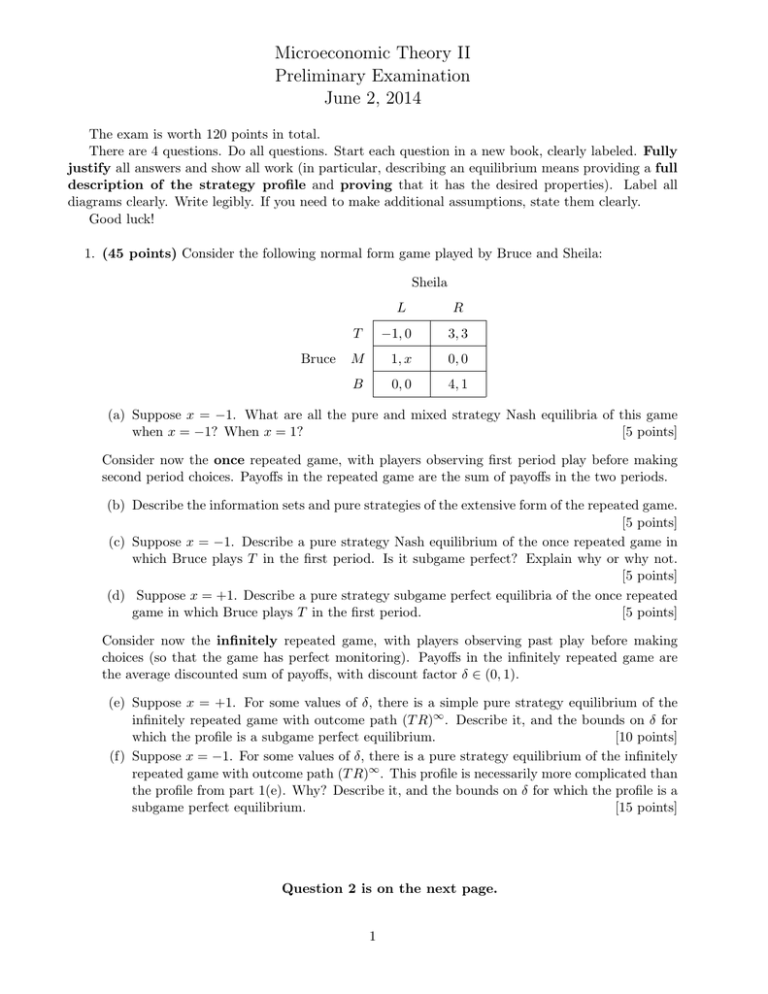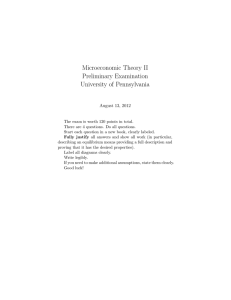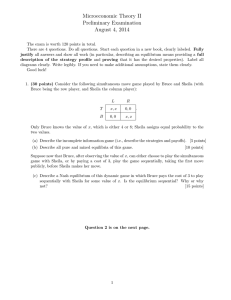Microeconomic Theory II Preliminary Examination June 2, 2014
advertisement

Microeconomic Theory II
Preliminary Examination
June 2, 2014
The exam is worth 120 points in total.
There are 4 questions. Do all questions. Start each question in a new book, clearly labeled. Fully
justify all answers and show all work (in particular, describing an equilibrium means providing a full
description of the strategy profile and proving that it has the desired properties). Label all
diagrams clearly. Write legibly. If you need to make additional assumptions, state them clearly.
Good luck!
1. (45 points) Consider the following normal form game played by Bruce and Sheila:
Sheila
L
Bruce
R
T
−1, 0
3, 3
M
1, x
0, 0
B
0, 0
4, 1
(a) Suppose x = −1. What are all the pure and mixed strategy Nash equilibria of this game
when x = −1? When x = 1?
[5 points]
Consider now the once repeated game, with players observing first period play before making
second period choices. Payoffs in the repeated game are the sum of payoffs in the two periods.
(b) Describe the information sets and pure strategies of the extensive form of the repeated game.
[5 points]
(c) Suppose x = −1. Describe a pure strategy Nash equilibrium of the once repeated game in
which Bruce plays T in the first period. Is it subgame perfect? Explain why or why not.
[5 points]
(d) Suppose x = +1. Describe a pure strategy subgame perfect equilibria of the once repeated
game in which Bruce plays T in the first period.
[5 points]
Consider now the infinitely repeated game, with players observing past play before making
choices (so that the game has perfect monitoring). Payoffs in the infinitely repeated game are
the average discounted sum of payoffs, with discount factor δ ∈ (0, 1).
(e) Suppose x = +1. For some values of δ, there is a simple pure strategy equilibrium of the
infinitely repeated game with outcome path (T R)∞ . Describe it, and the bounds on δ for
which the profile is a subgame perfect equilibrium.
[10 points]
(f) Suppose x = −1. For some values of δ, there is a pure strategy equilibrium of the infinitely
repeated game with outcome path (T R)∞ . This profile is necessarily more complicated than
the profile from part 1(e). Why? Describe it, and the bounds on δ for which the profile is a
subgame perfect equilibrium.
[15 points]
Question 2 is on the next page.
1
2. (15 points) Bruce owns a car he would like to sell to Sheila. Only Bruce knows the quality of
the car: it is either good or bad (a lemon). Sheila wants to buy the car only if it is good. Bruce
can try to convince Sheila about the car’s quality before Sheila makes her purchase decision. To
keep things simple, suppose that Bruce receives a payoff of 1 if he sells the car, and 0 otherwise,
and that Sheila receives a payoff of +1 from buying a good car, a payoff of −1 from buying a bad
car, and 0 otherwise.
(a) Describe the associated extensive form game, where we interpret “Bruce can try to convince Sheila about the car’s quality” as Bruce can announce “good” or “bad” before Sheila
makes her decision, and this announcement has not direct payoff implications. Be precise
in any additional assumptions you must make to obtain a fully specified extensive form
game.
[3 points]
(b) Is there an equilibrium of this game in which Sheila buys the car if and only if it is good?
Why or why not?
[5 points]
(c) Suppose that in addition to wishing to sell his car, Bruce does not like lying. How would
you alter Bruce’s payoffs to reflect this? How does this change your answer to part 2(b)
(you may restrict attention to pure strategies)?
[7 points]
Question 3 is on the next page.
2
3. (35 points) Suppose that the payoff to a firm from hiring a worker of type θ with education e
at wage w is
f (e, θ) − w = 4eθ2 − w.
The utility of a worker of type θ with education e receiving a wage w is
w − c(e, θ) = w −
e4
.
θ
The worker’s ability is privately known by the worker. There are at least two firms. The worker
(knowing his ability) first chooses an education level e ∈ R+ ; firms then compete for the worker
by simultaneously announcing a wage; finally the worker chooses a firm. Treat the wage determination as in class, a function w : R+ → R+ determining wage as a function of eduction.
Suppose the support of the firms’ prior beliefs ρ on θ is Θ = {θL , θH } where θL = 1 and θH = 4.
(a) What is the full information education level for each type of worker?
[5 points]
(b) Is there a perfect Bayesian equilibrium in which both types of worker choose their full
information eduction level? Be sure to verify that all the incentive constraints are satisfied.
[5 points]
(c) Suppose eL is the education level undertaken by θL , while eH is the education level taken
by θH in a separating Perfect Bayesian Equilibrium. What can you conclude about eH and
eL ? Be as precise as possible.
[10 points]
(d) Suppose the firms’ prior beliefs ρ are that the worker has type θH with probability 23 , and
type θL with probability 13 . Is there a pooling Perfect Bayesian equilibrium in this setting?
If yes, describe a pooling PBE and argue that it is one. If not, why not?
[10 points]
Now suppose the support of the firms’ prior beliefs on θ is Θ = {1, 3, 4}.
(e) Is there a perfect bayesian equilibrium in which each type of worker chooses her full information education level?
[5 points]
Question 4 is on the next page.
3
4. (25 points) A seller sells to a buyer with type θ ∈ Θ = [−1, 1]. If a buyer of type θ receives the
good with probability q in return for a payment of p, she has a net utility of:
2
u(q, p|θ) = e(θ ) q − p.
The seller uses a direct revelation mechanism. The buyer announces his type θ and receives the
good with probability q(θ) in return for a payment of p(θ).
(a) From first principles, state and prove necessary and sufficient conditions on q(·) for there to
exist a price p(·) such that (q(·), p(·) satisfies IC. Further, derive p(·) as a function of q(·)
in this setting. In other words, derive and prove the counterpart of the Fundamental IC
Lemma in this setting.
[20 points]
(b) The seller’s type is ω ∈ Ω = [1, 2], and if she sells the the good to the buyer with probability
q in return for a payment of p, she has a net utility of:
ω
u(q, p|θ) = p − e( 2 ) q.
Suppose the buyer’s and seller’s types are private to them. Suppose further the buyer’s type
is drawn uniformly from Θ, while the seller’s type is drawn uniformly from Ω, and the two
draws are independent. Does there exist an incentive compatible trading mechanism that is
individually rational and has no expected subsidy? Why or why not?
[5 points]
4






